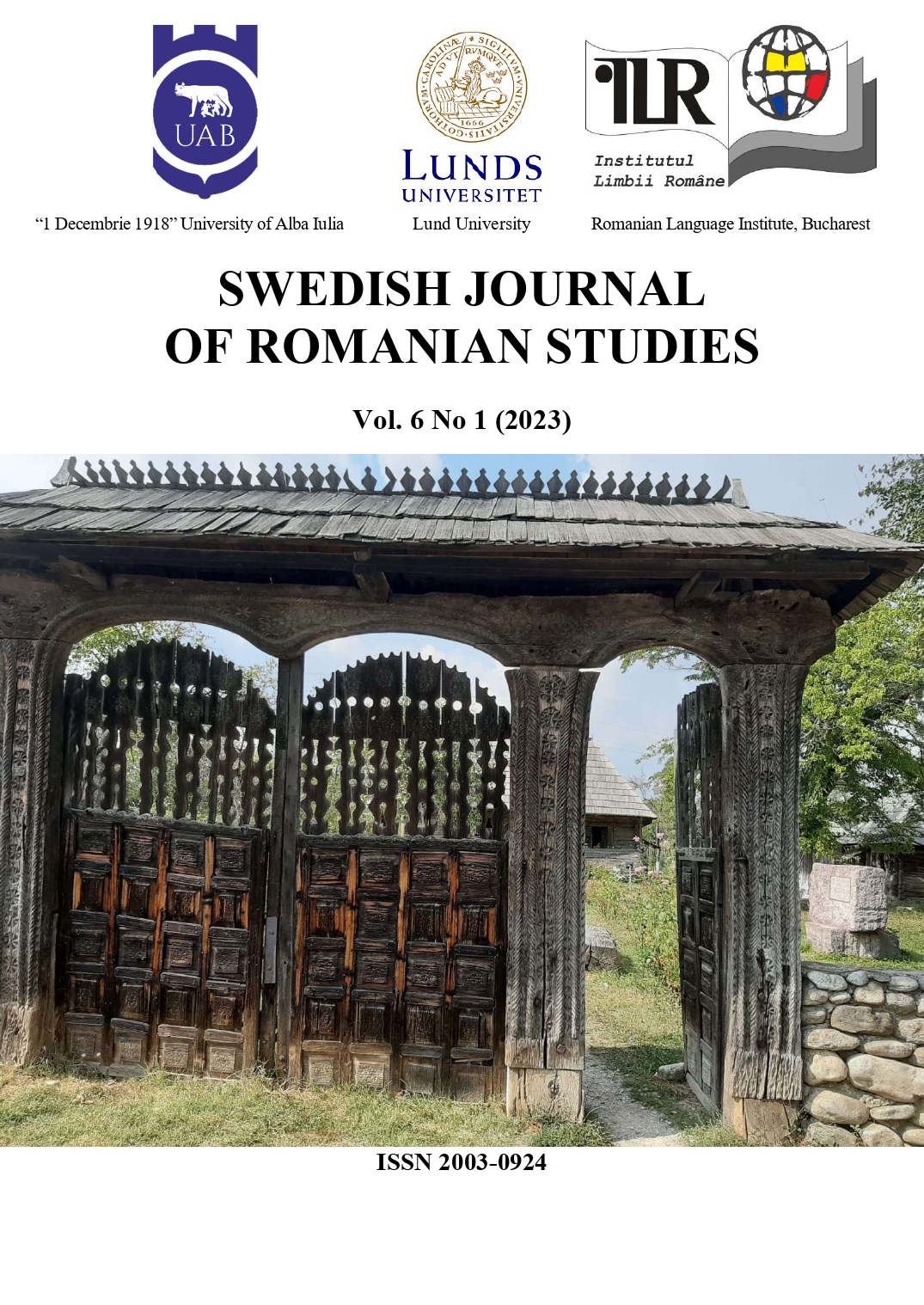Valahii (și nu numai ei), în Bucovina anilor 1788-1789
Wallachians (not solely them) in Bukovina during the years 1788-1789
DOI:
https://doi.org/10.35824/sjrs.v6i1.25084Keywords:
Bukovina, Balthasar Hacquet, imagology, anthropology, colonialismAbstract
Who is Balthasar Hacquet (1739-1815)? A universal man and Enlightenment figure, Balthasar Hacquet was a physician, surgeon, geologist, mineralogist, botanist, fascinated by plants and animals, chemist, karstologist, palaeontologist, as well as ethnographer, ethnologist and anthropologist.
The present study is prompted by the fact that between 1788 and 1789, Hacquet travelled through Bukovina, recently occupied by the Austrians, recording facts and giving testimonies on locals and settlers alike. The first part of the study analyzes the way Hacquet is published and received in Romania, between 1895 and 2007, from G. Bogdan-Duică (1895) to Nicolae Iorga, Leca Morariu, Radu Grigorovici, Leonte Ivanov. With insignificant exceptions, the most common opinion among Romanians is that Hacquet is unfair to the locals, conveying an unfavourable image of the Romanian-speaking population.
Considering such an assessment inadequate, the author proposes in the second part of the study a re-reading of Hacquet's travel notes from an imagological perspective. The proposed analysis does not aim at reprimanding Hacquet for his views, nor at correcting them. Instead it aims at problematizing his perspective as the consequence of all sorts of contexts. Consequently, the ideas conveyed by Hacquet take on complex meanings that go beyond the limits of a divide between cultures.
Finally, through the rereading it proposes, the study responds to its main objective, which is to dive into Hacquet's writing in order to reconstruct multiple aspects of life in Bukovina between 1788 and 1789.
References
Bogdan-Duică, G. (1895). Bucovina. Notițe politice asupra situației/ Bukovina. Political notes on the situation. Sibiu.
Ceaușu, M.Ș. & Lihaciu, I. (2021). Autonomia Bucovinei (1848-1861). Studii și documente/ The autonomy of Bukovina 1848-1861. Studies and records. Iași: Editura Universității „Alexandru Ioan Cuza”.
Cernovodeanu, P. (redactor responsabil), Holban M., Alexandrescu-Dersca Bulgaru M.M (2001). Călători străini despre Țările Române/ Foreign travellers about The Principalities of Wallachia, vol. X. Partea a II-a. București: Editura Academiei Române.
Hacquet, B. (2001). Prima călătorie.../ First travel.. In Cernovodeanu, P. (redactor responsabil), Holban M., Alexandrescu-Dersca Bulgaru M.M (2001). Călători străini despre Țările Române/ Foreign travellers about The Principalities of Wallachia, vol. X. Partea a II-a. București: Editura Academiei Române
Hacquet, B. (2002), Bucovina în prima descriere fizico-politică. Călătorie în Carpații Dacici (1788-1789). Recentele călătorii fizico-politice ale lui Hacquet în anii 1788 și 1789 prin Munții Dacici și Sarmatici sau Carpații Nordici/ Bukovina during the first physical-political description. Journey to Dacian Mountains between 1788-1789. The recent physical-political journeys of Hacquet through the Dacian and Sarmatian Mountains or Northern Mountains during 1788 and 1789. Ediție bilingvă îngrijită. Rădăuți: Editura Septentrion. (ediția I, Nürnberg, în editura Rasp, 1790).
Heitmann, K. (1995). Imaginea românilor în spațiul lingvistic german. 1775-1918. Un studiu imagologic/ The image of Romanians in the German language area. 1775-1918. An imagological study. (trad. Dumitru Hîncu). București: Editura Univers.
Iorga, N. (1981). Un naturalist german prin Bucovina, Ardeal și Moldova la sfârșitul secolului al XVIII-lea/ A German naturalist through Bukovina, Transylvania, and Moldavia at the end of the 18th century. In Istoria românilor prin călători/ The History of Romanians by Travellers. București: Editura Eminescu.
Ivanov, L. (2007). Oaza de necunoscut (Un breton pe meleaguri moldave)/ Unknown Oasis (A Breton on Moldavian Lands). In Transilvania, 10/2007. 54-56.
Morariu, L. (2015). Iraclie și Ciprian Porumbescu. Volumul II. Iraclie Porumbescu/ Iraclie and Ciprian Porumbescu, 2nd volume, Iraclie Porumbescu. Pătrăuți: Editura Heruvim.
Morariu, L. (1923). Războiul Troadei după Codicele Const. Popovici (1796)/ The Troad War after the codex of Constantin Popovici (1796). In Glasul Bucovinei, an. VI. Cernăuți: Institutul de Arte Grafice și Editură „Glasul Bucovinei”. 108.
Nistor, I. (1915). Românii și rutenii în Bucovina. Studiu istoric și statistic/ The Romanians and Ruthenians in Bukovina. Historical and Statistical Study. București: Editura Academiei Române.
Splény von Miháldy. G. (1998). Descrierea districtului bucovinean/ The Description of the District of Bukovina. In Bucovina în descrieri geografice, istorice, economice și demografice/ Bukovina in its first Geographical, Historical, Economical, and Demographic Description. București: Editura Academiei Române.
Šumrada, J. (2003). Sur les origines de Balthasar Hacquet/ On the origins of Balthasar Hacquet. In Hacquetia, 2/2. Disponibil pe: https://ojs.zrc-sazu.si/hacquetia/issue/view/257, consultat în 10 octombrie 2022.
Todorova, M. (2000). Balcanii și balcanismul/ Imagining the Balkans (Trad. Mihaela Constantinescu și Sofia Oprescu). București: Humanitas.
Downloads
Published
How to Cite
Issue
Section
License
Copyright (c) 2023 Mircea A. Diaconu

This work is licensed under a Creative Commons Attribution-NonCommercial 4.0 International License.
Authors who publish with this journal agree to the following terms:
a. Authors retain copyright and grant the journal right of first publication with the work simultaneously licensed under a Creative Commons Attribution-NonCommercial 4.0 International License that allows others to share the work with an acknowledgement of the work's authorship and initial publication in this journal.
b. Authors are able to enter into separate, additional contractual arrangements for the non-exclusive distribution of the journal's published version of the work (e.g., post it to an institutional repository or publish it in a book), with an acknowledgement of its initial publication in this journal.
c. Authors are permitted and encouraged to post their work online (e.g., in institutional repositories or on their website) prior to and during the submission process, as it can lead to productive exchanges, as well as earlier and greater citation of published work (See The Effect of Open Access).

